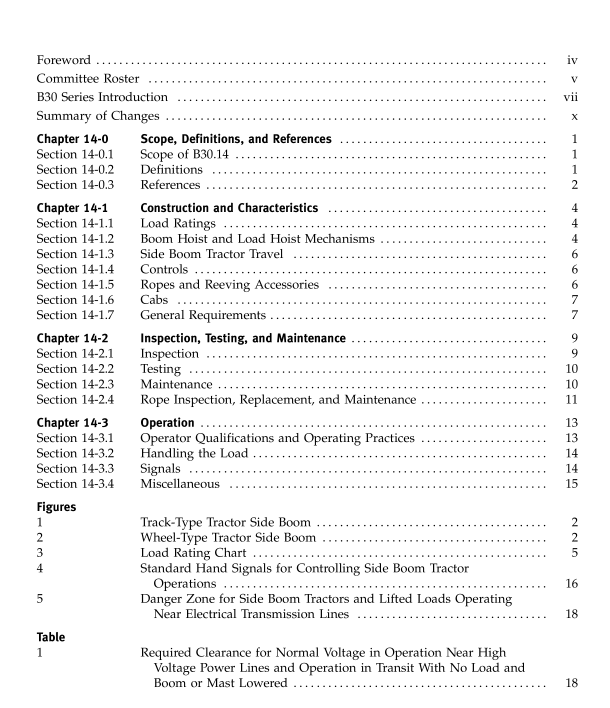ASME B30.14 pdf download

ASME B30.14 pdf download Side Boom Tractors Safety Standard for Cableways, Cranes, Derricks, Hoists, Hooks, Jacks, and Slings
If these standards are adopted for governmental use, the references to other national codes and standards in the specific volumes may be changed to refer to the corresponding regulations of the governmental authorities. The use of cableways, cranes, derricks, hoists, hooks, jacks, and slings is subject to certain hazards that cannot be met by mechanical means but only by the exercise of intelligence, care, and common sense.
It is therefore essential to have personnel involved in the use and operation of equipment who are competent, careful, physically and mentally qualified, and trained in the safe operation of the equipment and the handling of the loads. Serious hazards are overloading, droppingorslip- pingofthe load caused byimproper hitchingorslinging, obstructingthe free passage of the load,andusingequipment for a purpose for which it was not intended or designed.
The Standards Committee fully realizes the importance of proper design factors, minimum or maximum sizes, and other limiting dimensions of wire rope or chain and their fastenings, sheaves, sprockets, drums, and similar equipment covered by the Standard, all of which are closely connected with safety. Sizes, strengths, and similar criteria depend on many different factors, often varying with the installation and uses. These factors depend on the condition of the equipment or material;
the loads; the acceleration or speed of the ropes, chains, sheaves, sprockets, or drums; the type of attachments; the number, size, and arrangement of sheaves or other parts; environmental conditions causing corrosion or wear; and many variables that must be considered in each individual case. The rules given in the Standard must be interpreted accordingly, and judgment must be used in determining their application. The Standards Committee will be glad to receive criti- cisms of this Standard’s requirements and suggestions for its improvement, especially those based on actual experience in application of the rules. Suggestions for changes to the Standard should be submitted to the Secretary ofthe B30 Committee, ASME, Three Park Avenue, New York, NY 10016-5990, and should be in accordance with the following format:
(a) Cite the specific paragraph designation of the per- tinent volume.
(b) Indicate the suggested change (addition, deletion, revision, etc.).
(c) Briefly state the reason and/or evidence for the suggested change.
(d) Submit suggested changes to more than one para- graph in the order that the paragraphs appear in the volume. The B30 Committee will consider each suggested change in a timely manner in accordance with its procedures.
SECTION I: SCOPE This Standard applies to the construction, installation, operation, inspection, and maintenance of jacks; power- operated cranes, monorails, and crane runways; power- operated and manually operated derricks and hoists; lifting devices, hooks, and slings; and cableways. This Standard does not apply to track and automotive jacks, railway or automobile wrecking cranes, shipboard cranes, shipboard cargo-handling equipment, well-drilling derricks, skip hoists, mine hoists, truck body hoists, car or barge pullers, conveyors, excavating equipment, or equipment falling within the scope of the following Committees: A10, A17, A90, A92, A120, B20, B56, and B77.
SECTION II: PURPOSE This Standard is designed to (a) guard against and minimize injury to workers, and otherwise provide for the protection of life, limb, and property by prescribing safety requirements (b) provide direction to owners, employers, supervi- sors, and others concerned with, or responsible for, its application (c) guide governments and other regulatory bodies in the development, promulgation, and enforcement of appropriate safety directives









